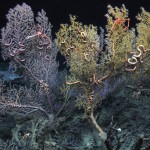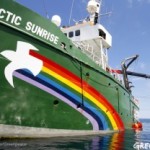Fresh out of the NOAA news office:
[…] Operating from the NOAA Ship Ronald H. Brown and using a variety of tools including the National Deep Submergence Facility’s Jason II remotely-operated vehicle (ROV), researchers were working at a site 1,400 meters deep (roughly 4,600 feet) and approximately seven miles southwest of the Macondo wellhead when they visually observed dead and dying corals with sloughing tissue and discoloration.
Charles Fisher, Ph.D., professor of biology at Penn State University and chief scientist on the expedition, described much of the soft coral observed in an area measuring about 15 to 40 meters as covered by what appeared to be a brown substance. Ninety percent of 40 large corals were heavily affected and showed dead and dying parts and discoloration. Another site 400 meters away had a colony of stony coral similarly affected and partially covered with a similar brown substance. […]
We keep iterating it here and you hear it elsewhere. The problems will not be at the surface so much at this stage. The effects of this massive input of oil is going to really manifest itself in the deep sea. This is not good. Deep sea corals are very important components of the deep Gulf of Mexico ecosystem and may provide habitat for commercially important fisheries.





